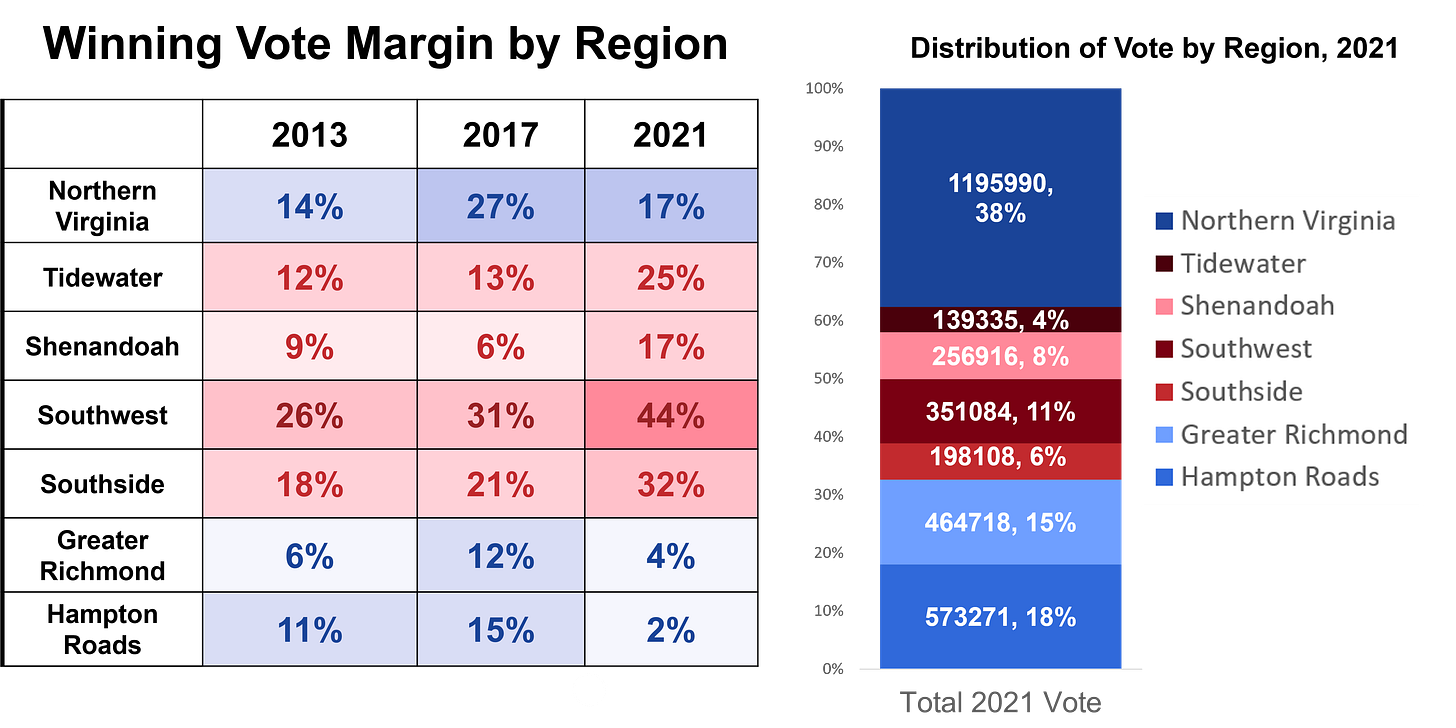Certified: Virginia's 2021 Gubernatorial Election
Virginia previews a rural reckoning for Democrats in 2022.
Topline Takeaways
Rural Virginia is only getting redder and helped tip the scale in favor of Youngkin. As Democrats have largely given up campaigning in rural counties, voters in these areas continue to peel away toward Republicans in large numbers.
McAuliffe lost in many of the state’s suburbs, just not the ones everyone was watching. Despite nationwide coverage of tense school board meetings in Loudoun county, McAuliffe beat his previous performance in the Northern Virginia suburbs, further complicating the narrative of his loss.
Youngkin clinched the win by returning much of Southern Virginia to the Republican party. In both 2013 and 2017, Republican gubernatorial candidates ran more than 10-points behind their Democratic challengers in Southern Virginia. This time around, Youngkin only lost to McAuliffe by 2 points in Hampton Roads and managed to flip several suburban municipalities in the region.
Rural Virginia is only getting redder.
While most of the attention in this election was focused on the eastern regions of the state, Glenn Youngkin’s win is in part due to continued shifts toward the Republican party in the state’s mountainous western regions.
Despite the relatively small populations of counties falling within the Southwest and Shenandoah regions (together the two regions are only responsible for ~20% of the statewide vote) Republicans have increasingly produced landslide victories among this rural electorate. Conversely, Democratic candidates have largely given up campaigning in these regions to their detriment. Alleghany county, lying just to the east of West Virginia, presents a great example of the collective power of these small counties. In 2013, McAuliffe lost to his Republican challenger here by only 300 votes but eight years later McAuliffe lost by more than 3,000 votes. That spread alone is responsible for 5% of the 63,000-vote margin statewide that separated Youngkin and McAuliffe. The problem for Democrats: a whopping 32 of the 52 counties in these two regions resemble Alleghany where Republicans capture an increasingly outsized share of the votes.
While turnout was up dramatically compared to past gubernatorial elections (55% registered voter turnout in 2021, up from 47% turnout in 2017) this increased turnout was distributed unevenly across the state. Counties won by McAuliffe averaged a roughly 18% increase in total votes when compared to 2017. That figure is absolutely dwarfed by counties won by Youngkin which saw an average of a 33% increase in total votes, proving that Youngkin bested in McAuliffe in stoking turnout among base voters.

Shifting Southern Suburbs
Despite media coverage spotlighting school board drama in Loudoun county, Northern Virginia turned out for Terry McAuliffe and supported the Democratic candidate even more strongly than his nail-biting finish in 2013. While 2017 proved to be a “blue-wave” year for the region (voters here supported Democrat Ralph Northam by a whopping 27-point margin) the expected drop-off of suburban Democratic votes wasn’t as catastrophic as many predicted in the northern reaches of the state. While most of these NOVA counties had considerably lower winning margins for McAuliffe, Youngkin was only able to flip Stafford county (when compared to the 2020 presidential election) and Loudoun still supported the Democratic party by a comfortable 11-point margin.
The same can’t be said about Southern Virginia. Counties surrounding Richmond and Hampton Roads saw a significant drop in Democratic margins, both to new lows below McAuliffe’s past margins in 2013. When comparing to the most recent presidential election, Youngkin managed to flip Virginia Beach, Chesapeake and Chesterfield county; municipalities that all fall among the top 10 most populous within the state. All three of these municipalities leaned toward Republicans in the pre-Trump era and only flipped to Democrats in recent years. This helps prove that shifts toward Democrats in Southern Virginia are demonstrably different than those seen in Northern Virginia. Most NOVA voters seem to sit firmly with Democrats following the Trump presidency while many SOVA voters seem to be “reluctant Democrats” who only supported the party to prevent the rise of Donald Trump.
To be clear, Democrats are not necessarily “losing voters” in these areas. They’ve increased their vote totals in almost every county across the state in each subsequent gubernatorial election. The problem is that they’re failing to keep pace with Republicans who are building a coalition much more quickly than Democrats.





